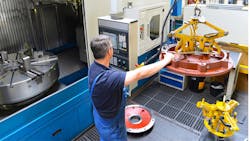Industrial Production to Rise 4% in 2014, Business Economists Predict
Business economists raised their forecast for U.S. industrial production to 4.0% from 3.7% in June, according to the latest quarterly business outlook survey from the National Association for Business Economists.
While generally optimistic about the remainder of 2014 and 2015, NABE tempered their expectations for GDP growth. In March, the group forecast that GDP growth from Q4 2013 to Q4 2014 would be 2.7% but the group now predicts it will be 2.0% because of the “sizable decline early in the year.” NABE said GDP would grow at about 3% for the third and fourth quarters of 2014. It said real GDP would rebound from 2014’s 2.0% to 2.9% in 2015.
“Panelists are more optimistic in their forecasts for business fixed investment, government outlays and international trade activity than they were in June, but their expectations for consumer spending and residential investment are lower, citing weak income growth and difficulty in accessing credit as primary factors hampering growth in those categories,” said NABE President-Elect John Silvia, chief economist at Wells Fargo.
NABE members were more upbeat about employment, raising their forecast for average monthly job gains to 228,000 in 2014 from the 209,000 predicted in June. While they predicted the monthly average would slip to 211,000 in 2015, that was an increase from the 209,000 average estimated in the summer. The economists pegged the unemployment rate at 6.1% for 2014 and 5.7% in 2015.
Expectations for nonresidential equipment and software investment also rose as NABE members said it would grow by 3.7% this year, rather than the 3.2% forecast in June. They said investment in 2015 would increase even higher, to a 4.2% rate. Inventory investment is expected to measure $67.0 billion in 2014 and $56.6 billion in 2015, compared to $63.5 billion in 2013.
NABE panelists expect U.S. exports to grow 3.2% in 2014, an increase from the 3.0% of 2013 but substantially less than the 5.5% growth they forecast in March. However, they raised their expectations for 2015 to 5.7% growth from 5.6% in June.
The business economists don’t predict the federal deficit is going away any time soon but they do see it dropping to $507 billion in fiscal 2014, down from their June estimate of $520 billion. However, their estimate of $490 billion in fiscal 2015 is up from their June prediction of $475 billion.
Detroit and its global brethren sold 15.5 million light vehicles in 2013. NABE panelists raised their sales forecasts for this year to 16.3 million units and for 2015 to 16.7 million vehicles.
Gas should cost about the same for motorists buying all those cars. NABE expects the price of a barrel of oil to be $98, unchanged from 2013, and to average $97 in 2015.
While optimistic about auto sales, the economists were less sanguine about consumer spending overall. In the September survey, they pegged personal consumption expenditures growing at 2.3% for 20114, down from their June estimate of 2.9%. They also forecast a slightly less optimistic 2015, with expenditures rising 2.8% rather than the 2.9% seen in June.
About two-thirds of NABE’s panel said the main reason for weaker personal consumption growth was weak personal income growth. Another 28% cited poor labor market conditions.
About the Author
Steve Minter
Steve Minter, Executive Editor
Focus: Leadership, Global Economy, Energy
Call: 216-931-9281
Follow on Twitter: @SgMinterIW
An award-winning editor, Executive Editor Steve Minter covers leadership, global economic and trade issues and energy, tackling subject matter ranging from CEO profiles and leadership theories to economic trends and energy policy. As well, he supervises content development for editorial products including the magazine, IndustryWeek.com, research and information products, and conferences.
Before joining the IW staff, Steve was publisher and editorial director of Penton Media’s EHS Today, where he was instrumental in the development of the Champions of Safety and America’s Safest Companies recognition programs.
Steve received his B.A. in English from Oberlin College. He is married and has two adult children.
